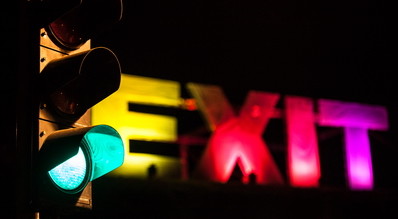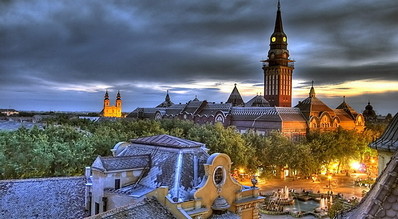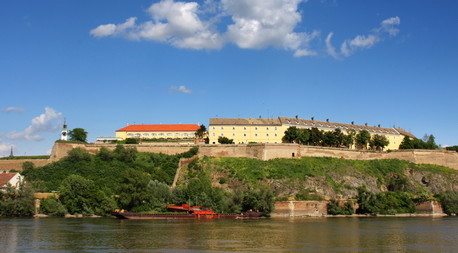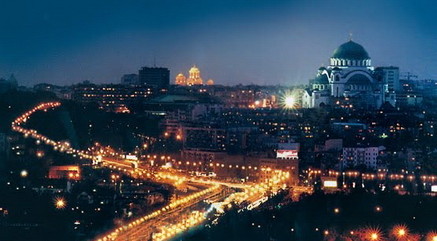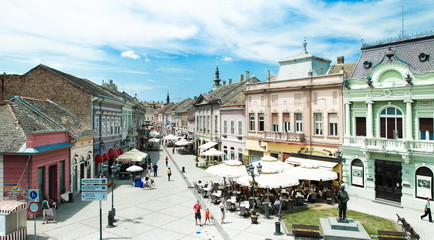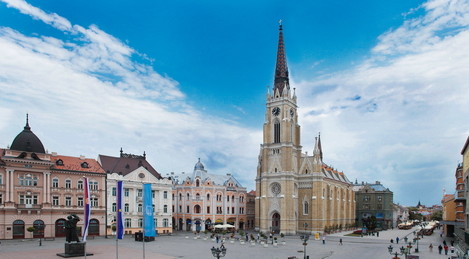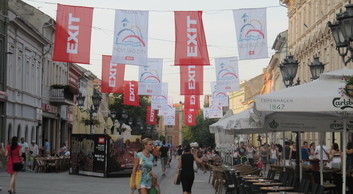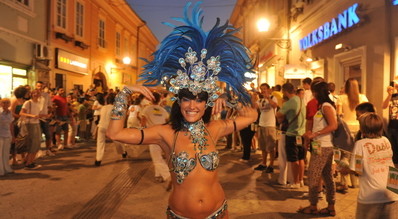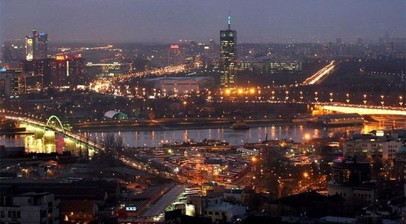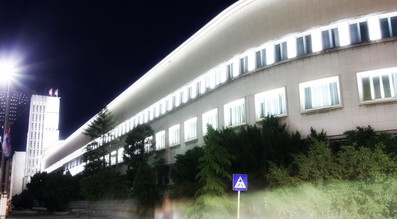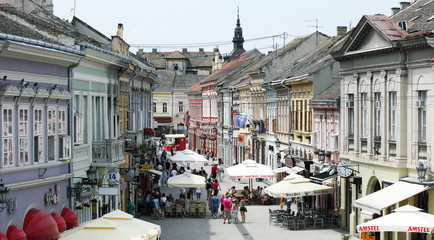The Republic of Serbia is a country located at the crossroads of Central and Southeast Europe, covering the southern part of the Pannonian Plain and the central Balkans. The country is landlocked and borders Hungary to the north; Romania and Bulgaria to the east; FYR Macedonia to the south; and Croatia, Bosnia and Herzegovina, and Montenegro to the west; also, it borders Albania through the disputed region of Kosovo*. The capital of Serbia, Belgrade, is among Europe’s oldest cities, and one of the largest in East Central Europe.
Serbia has connected West with East for centuries – a land in which civilisations, cultures, faiths, climates and landscapes meet and mingle.
It is located in the centre of the Balkan Peninsula, in southeastern Europe. The northern portion belongs to central Europe, but in terms of geography and climate it is also partly a Mediterranean country. Serbia is landlocked but as a Danube country it is connected to distant seas and oceans. Serbia is a crossroads of Europe and a geopolitically important territory. The international roads and railway lines, which run through the country’s river valleys, form the shortest link between Western Europe and the Middle East.
From the agricultural regions of the Pannonian Plain in the north, across the fertile river valleys and orchard-covered hills of Šumadija, the landscape of Serbia continues southward, gradually giving way to mountains rich in canyons, gorges and caves, as well as well-preserved forests. Serbia’s beautiful mountains, national parks, rivers and lakes are the perfect location for an active outdoor holiday – from hunting and fishing to extreme sports.
Many times during its rich, centuries-long history, Serbia has been at the centre of Europe’s and the world’s attention, out of all proportion to its modest size, economic might and number of inhabitants. Many lessons on bravery, patriotism and the struggle for freedom can be learned wherever you turn in Serbia, as you pass through its cities and regions.
The cultural and historical heritage of Serbia begins with prehistoric archaeological sites and its legacy from classical antiquity. Perhaps its greatest riches, though, are in the many mediaeval Serbian churches and monasteries, some of which are included on the UNESCO World Heritage list.
All year round, numerous cultural, entertainment, traditional and sporting events are held in Serbia, demonstrating the creative power and spiritual vitality of this country.
Today, Serbia is a modern, democratic European country, on the path to membership of the European Union, which a diverse range of visitors – from young backpackers to participants in congresses and fairs – visit every day.
Statistically, the most-visited tourist destinations are the cities of Belgrade and Novi Sad, the mountains of Kopaonik and Zlatibor and the spa towns of Vrnjačka Banja and Sokobanja.
About Event
EXIT Festival
EXIT, the best European festival, is a summer music festival held every July for four days at the Petrovaradin Fortress in Novi Sad, Serbia. EXIT’s key stages are the Main Stage, Dance Arena, Fusion, Riffs&Beats, Reggae Stage, Happynovisad Stage, accompanied by various smaller ones.
The 15th edition of the best European festival is going to be EXIT ADVENTURE that will take us to ROCK@EXIT on 11th June – an additional one day prequel festival headlined by Queens of the Stone Age – to the EXIT festival, held from 10th to 13th July 2014 at the Petrovaradin fortress in Novi Sad, all the way to the SEA DANCE FESTIVAL from 15th to 17th July at the Jaz beach, one the most stunning beaches of Adriatic.
Exit won the’Best Major European Festival Award’ on European Festival Awards 2013, it won the ‘Best European Festival’ award at the UK Festival Awards in 2007,and was ranked one of the 10 best major festivals at European Festival Awards 2009, 2010, 2011 and 2012 and one of the 10 Best Overseas Festival at UK Festival Awards 2013.
More than 2,5 milllion people from over 60 countries around the world have visited the festival so far. Known for its incredible atmosphere, and one of the best Dance Arenas in the world and unique location, it offers visitors the most exciting, versatile summer adventure. During 4 days there are from 150 to 200 000 visitors, of which there are at least 23 000 foreign tourists and 7000 visitors from the Balkans.
The Exit festival was founded in 2000, as a student movement, fighting for freedom and democracy in Serbia.
Read MoreEXIT FOUNDATION
was founded in 2010 in Novi Sad with its main goal in helping young citizens of Novi Sad to gain new academic experiences through financing and co-financing their scholarships and academic projects. Since 2013, Exit has a goal to participate in mobilizing current opinion and deciding on two areas it has been known for: destination branding and youth development. State of Exit Foundation dedicates its work to key topics in social involvement: national branding, regional connection through creative industries, as well as promoting positive examples to the youth. It has organized REBRANDING SERBIA conference in Novi Sad in July 2013, as well as the Creative Industries Coneference (KKIS) held in Belgrade on February 2014.
The EXIT LABEL
was created in February 2009 with the desire to offer local and regional performers better promotion through free downloads and live performances at the festival. – EXIT TRIP Travel info and ways to get to EXIT are at the EXIT Trip website, here.
QUICK FACTS – QUICKER THAN MARVEL’S FLASH
• EXIT Festival 2014 takes place from 10th to 13th July.
• It lasts for four incredible, intense days during the smooth summer of a continental climate.
• The LINE-UP currently includes DAMON ALBARN / GLORIA GAYNOR / AFROJACK vs QUINTINO / CARL COX vs DANNY TENAGLIA / DISCLOSURE LIVE / RUDIMENTAL LIVE / SKRILLEX / ANDY C / ASIAN DUB FOUNDATION / BEN KLOCK vs MARCEL DETTMANN / CARL CRAIG vs GREEN VELVET / DIMENSION / DUB FX / DUSKY vs PAUL WOOLFORD / EATS EVERYTHING vs CASSY / FRED V & GRAFIX feat DYNAMITE MC / GORGON CITY / HEIDI vs KIM ANN FOXMAN / JACKMASTER & ONEMAN PRESENTS ‘CAN U DANCE’ / JAMBINAI / KOVEN LIVE / MACEO PLEX vs DANNY DAZE / MIGHTY OAKS / MY NU LENG / PLANETARY ASSAULT SYSTEMS LIVE / PRETTY LIGHTS Live Visual Show / SUB FOCUS / TC / THE AFGHAN WHIGS / TIGA vs DJ HELL / TRICOT See the current band list here.
• The biggest stages are Main Stage, Dance Arena, Fusion Stage, Reggae Stage, Happy Novi Sad Stage, with more smaller, more intimate ones, that change their name and location each year.
• The Main Stage’s capacity is about 25 000, and Dance Arena can hold about 20 000 visitors.
• The festival is held at the medieval Petrovaradin Fortress, on the Danube river, overlooking Novi Sad.
• The country’s capital Belgrade is about 94 kilometres away from Novi Sad (about an hour and a half drive) and is close to the Nikola Tesla Airport. See practical travel info at our EXIT TRIP page here.
• EXIT’s been held for 14 years now (Founded in 2000)
• Over the years, EXIT organization has also welcomed names such as Red Hot Chilly Peppers, The Prodigy, Depeche Mode, Billy Idol, Madonna, Nick Cave, Moby, David Guetta and many more, who performed in Serbia in organization of the Exit team.
• Our 2013 highlights video is here.
A FEW KIND WORDS ABOUT THE FESTIVAL
EXIT is an award winning summer music festival held every July since 2000 at the Petrovaradin Fortress in the city of Novi Sad, Serbia. It was officially proclaimed the ‘Best Major European festival in 2013’ at the EU Festival Awards 2014.
More than 2.5 billion people from over 60 countries around the world have visited the festival so far. Young people from all over Serbia and Europe come to enjoy themselves each year.Watch our 2013 highlights video here.
EXIT’S KEY STAGES:
The Main Stage of the Exit festival is situated at the very heart of Petrovaradin Fortress, with its capacity of over 25,000 people, with a scenic natural backdrop. Every year the Main Stage welcomes renowned stars and artists from all music genres. Along with the most popular performers, it also features the best electronic acts in the UKF X-Bass Takeover program, which have become a trademark of the festival, allowing the party to continue until dawn.
The Dance Arena is the second largest Exit festival stage, and can host over 20,000 people. The show on the Dance Arena starts in the evening, and plays all night long, until dawn. In previous years the Dance Arena has hosted some of the most influential DJs and producers in the world, such as: Carl Cox, Sven Väth, Laurent Garnier, Frankie Knuckles, Green Velvet, Darren Emerson, Dave Clarke, Jeff Mills, Eric Prydz, Richie Hawtin, Lee Burridge, Avicii and many others.
The Fusion Stage is one of the biggest stages at the festival. It played host to some of the most prominent rock, pop, and alternative performers, both from Serbia and the rest of the world.
The Riffs&Beats Stage (previously Explosive stage) is the place for the harder music genres: Metal, HC, Punk.
The Happynovisad Stage is the one of the largest electronic stages at the festival. Happynovisad Stage came to life in 2005. In December 2010, it started live video streaming, and became the gathering place for the most popular local and regional DJs.
The Reggae Stage is a chillout zone for fans of jamaican sounds that hosts about a thousand visitors near the City Museum of Novi Sad.
There are also smaller, more intimate stages too, but we won’t list them until we have more info to share.
Must See
Destinations
Discover, arrive and enjoy!
1. BELGRADE NIGHT LIFE
Belgrade’s nightlife is well and truly awake and in this city you can have a lot of fun. Belgrade has a reputation for its nightlife, and with good reason. Unlike in other parts of Europe, there is no day in the week in Belgrade when you cannot have a night out. This is true whatever your age, whatever your lifestyle and however much you want to spend.
In Belgrade every day is treated like Friday – people think nothing of clubbing through the night and going straight into work the next morning. That may sound unimaginably hedonistic to people from a nation where almost everything shuts up at 11pm, but Belgrade’s all-night bars and clubs and very cheap booze. Serbs never go out before midnight in clubs, so your evening should start in one of the trendy bars or restaurants.

A lot of night clubs, bars and floating clubs along the riverbanks make Belgrade nightlife some of the most exuberant in Europe. Clubs and bars in Belgrade compete with the rest of Europe in their décor and taste in music. With some located inside the walls Kalemegdan Fortress, hidden in passages or up stairwells, they serve up world-class live and DJ music and often stay open well into the late hours for a stylish clientele that knows how to have fun.
Most venues are open until 4am from Tuesday through to Sunday, and some famous venues can open even on Monday. Cafes and bars are usually open until 1am every day. Entrance is usually free of charge.
The music stretches from well-known European and local DJs playing house, hip-hop, R&b or drum’n’bass to the beats of turbofolk pounding into the night.
Back in 1999, Belgraders held outdoor concerts while undergoing NATO bombardment, a feat that bewildered many outsiders. The long years of bad press that kept Serbia and its energetic capital off the map have now passed, and foreigners are now realizing what locals always knew – that Belgrade really rocks.
With an exuberant population and its legacy as an intellectual hangout, Belgrade offers intriguingly varied nightlife, ranging from eclectic watering holes for those in the know, to the busy restaurants and bars of the Skadarlija district and the summer clubs in heaving barges on the Sava and Danube Rivers. Major international musicians hit Belgrade’s Sava Center, and the summertime EXIT Festival, held an hour north in Novi Sad, is one of Europe’s best.
Read More2. PETROVARADIN FORTRESS
The pearl of Serbian heritage, the Gibraltar on the Danube River, the unconquerable fortress. If you give it a look you will immediately notice its magic and secrets. If you venture under the ground, there are 16 km of catacombs and tunnels, open to visitors with an adventurous spirit. Visits are available only with a previous appointment that must be made with the guide service sector at least a few hours in advance. Nevertheless, one should come back to the surface to see the most beautiful sunset view in Novi Sad. From the upper plateau of the Fortress the whole city is visible, as if it stood on the palm of one’s hand. Former military structures conceal a few small taverns and inns with pleasant ambience. In these baroque surroundings with a magnificent view, sip homemade brandy, called rakija, or wine from the slopes of Fruška Gora, and you will experience the true pleasure and happiness of being in Novi Sad!

One of the most emblematic sights on the fortress is the drunken clock on the upper platform. Check it out. Can you recognize what time it is? The secret is that the hands have switched places. The small one shows the minutes and the big one – hours. If you were a sailor looking at this watch from a distance this would make much more sense.
Tired of thinking about the passage of the time? Take a stroll. The time has stopped here in the 18th century. Not much has changed since then. In the City museum you will discover who has conquered this fortress before you: Neolithic people, Celts, Romans, Huns, medieval empires, the Habsburgs, the Turks…
Feeling artistic or dreamy? Go to one of the numerous art ateliers and galleries, to the Observatory or The Academy of the Arts.
EXIT FESTIVAL the biggest music event in Southeast Europe, has been taking place on Petrovaradin fotress since 2001, gathering some of the most famous musicians on the planet and visitors from all continents. The Festival is visited by 50,000 people per day. Besides the magical atmosphere felt all by visitors and participants of the Festival, the fortress offers superior acoustics with amazing possibility to have different events, which are quite close to each other, at the same time without the interference of sound.
3. DEVIL’S TOWN (ĐAVOLJA VAROŠ)
In the south of Serbia, 27 km south-east of Kursumlija, lies a first-class natural landmark – Djavolja Varos (”Devil’s Town”). Two rare natural phenomena at the same spot: 202 stone formations created by erosion, between two and 15 meters in height and the middle diameter of under 1 m, topped by stone blocks weighing as much as 100 kg, appearing unreal and yet lasting for centuries, and two springs of extremely acid water (pH 1,5) with high mineral content (15 g/l; content of some elements even 1000 times as high as in ordinary drinking waters) make Djavolja Varos a true wonder of nature.

The natural surrounding area adds to the attraction of these two wonders, depicting a rather harsh, almost mystical atmosphere, but at the same time picturesque and timid, just like the remains of the town, old church, cemetery, and several interesting mines.
Djavolja Varos has been put under protection of the state in 1959, while in 1995, by the Decision of the Serbian Government, it was declared the natural good of an outstanding importance, giving it the first-category level of protection – NATURAL MONUMENT. Thus, the whole 67 hectares of its territory are protected.
THE SOIL FIGURES
The site of a strange name “Devil’s Town” is located near an also strangely named village Djake (comes from a Turkish word “gjak” – blood), at an altitude of 660-700 m, situated in the municipality of Kursumlija. Earthen figures or “towers” as the locals call them are located in the watershed between two gullies, whose sources joined together create a unique erosive formation, tremendously demolished by the erosive processes. The gullies also have strange names: “Devil’s Gully” (“Djavolja jaruga”) and “Hell’s Gully” (“Paklena jaruga”).
There are 202 earthen figures of different shape and dimension, from 2 m to 15 m in height, and from 0.5 m to 3 m in width, with stone caps on the top. They are an outcome of a specific erosive process that lasts for centuries. When figures are formed, they grow, change, shorten, gradually (very slowly) disappear and reappear. The loose soil is dissolved and washed away by the rain. However, the material under the stone caps is protected from the “bombardment” of the rain drops and washout, and remains in place in the form of the rising earthen pillars – figures.
The height of the pillars is increased by a quick linear and directed erosion of water which flows away around their feet, washing out the material. Due to the steep incline of the terrain where figures are formed, vertical erosion prevails over the lateral one, which accelerates the washout of the material and the creation of the pillars.
Formed in this way, the earthen pillars are shaped into earthen figures of strange shape and appearance by various environmental factors (wind, sun, changes of temperature, etc). When observed for a long time, the figures appear unreal, both in their shape and dimension, as well as in their incredible static perseverance. It seems unreal that an earthen figure which is 3 m wide in its foot and more than 10 m tall becomes 20-30 cm wide at the top and endures for decades and centuries under the weight of more than 100 kg heavy stone block…
LEGEND
There are many legends about „Devil`s town.“, we present one of them to you.
According to the first legend, long time ago, this area was inhabited by humble, calm and religious people. This annoyed the devil so he made “Devil’s Water” to make them forget their lineage. As the inhabitants drank the water, they arranged a marriage between a brother and a sister.
The devil’s plan was interrupted by the fairy who, according to the legend, still keeps this area under her protection. The fairy could not reason with them, so the bride and the groom were on their way to church. At that moment, the fairy started praying to somehow end the incest. God heard her prayer and joined the earth with the sky, then the cold wind blew and God turned the wedding guests into stone.
4. MEĆAVNIK DRVENGRAD
A visit to the tourist center Mecavnik, also known as Drvengrad (Timber Town), on the Mokra Gora mountain in western Serbia, as the entrance to a new, different world, as it is not just a common tourist complex. At the very gates, visitors are aware of unusual details – every “street”, even with only one cottage in it, and every “square” bears the ame of one of the famous people from the world of art, sports or other spheres.

Plenty of books everywhere, models of boats, old timer cars, unusual sculptures, numerous photos, original motives, decorated walls, furniture, chandeliers and lamps – all those make Drvengrad interesting and unique. The guests have an impression of treading through a different world, as if they were part of a fairytale, theatre play or a movie.
All this should be no surprise, having in mind that the owner and creator of the complex is the renowned film director Emir Kusturica, whose work earned awards at film festivals in Cannes, Venice, Berlin. So, the people for whom he has admiration are presented in Drvengrad. In other words, there are streets named after Ivo Andric, Branislav Nusic, Federico Fellini, Ingmar Bergman, Jim Jarmush, Novak Djokovic, Bruce Lee, Che Guevara; and the squares “belonging” to Nikola Tesla, Nikita Mikhalkov, Diego Maradona; as well as the “Stanley Kubrick” theatre. The town also has a sports-recreational center “Damned Yard” (named after the novel of Ivo Andric), with the swimming pool “Milorad Cavic”. Then, there is a town prison “Humanism and Renaissance”, as well as the “Writers’ house” with Dostoevsky’s portrait on the façade. Standing in the central spot is the church of St Sava.
All cottages in Drvengrad are, naturally, made of wood from the surrounding mountains of Mokra Gora, Tara and Zlatibor. Streets and alleys and staircased are paved in stone and old railroad tiles. Not far from there is the starting station of the famous “Sargan eight loop” – a narrow gauge train that “cruises” Mt Mokra Gora and offers tourists a special experience and view of those landscapes. Wood is also prevalent in rooms, restaurants and other facilities in Drvengrad, and the wooden walls of the restaurant are aligned with shelves that carry books and wine bottles. On one section of that wall is an unusual door with a silhouette of a mysterious girl, heading in an unknown direction, which tickles the imagination of the visitors.
Drvengrad was built in 2003 and has been growing ever since, without disturbing the harmony with the environment. This unusual tourist complex attracts visitors from all over the world. It is also where the international film and music festival Kustendorf is held every year. For his project of the wooden town, in 2005 Kusturica received the European architectural award “Phillip Rottier”.
5. BELOCRKVANSKA LAKES
Lakes of Bela Crkva are located in the extreme southeast of Vojvodina, on the border with Romania. Bela Crkva is hundred kilometers away from Belgrade. Lakes were formed by exploitation of gravel from the bottom of the former Pannonian Sea, and they are different in size and depth, but all lakes are extremely rich in fish, and represent a real challenge for fishermen. There is a City Lake in Bela Crkva, which has beautiful beaches, restaurants and bungalows, and a car-camp. As there are no industrial pollutants in the vicinity of Bela Crkva, this area is environmentally very clean, especially water, which is characterized by a special clarity and purity.

Not far from Bela Crkva, in the southeastern part of Vojvodina, in the Banat district, there are 7 artificial lakes, including the Glavno, Vračevgajsko, Šaransko and Šljunkara. These were formed by the excavation of gravel from the former bed of the Pannonian Sea. The pebbly and sandy shores give the lake waters beautifully clear. The lakes and their surroundings are ideal for leisure and daytrips.
They are teeming with fish (such as grass carp, perch, carp and catfish), presenting a real treat for anglers. The best known lake is the Glavno or Gradsko Jezero, which has a water polo area, diving boards, showers and a campsite. The beach is partially paved, but all the other lakes have completely natural beaches. This lake is a venue for summer swimming, diving and sailing schools. An important asset is the pure, clear water, rarely to be found elsewhere. Besides the lakes, bathing is also possible on the rivers Nera and Karaš, with the waters of the Danube and the Danube-Tisa-Danube canal rounding off the experience in this unique natural environment.
6. UVAC SPECIAL NATURE RESERVE
Uvac River flows between the northern cliffs of gorgeous Zlatar Mountain and the southern cliffs of Zlatibor Mountain chains and slopes of Javor Mountain. Uvac River is situated in Western Serbia, about 250 km south of Belgrade and forms several artificial lakes thanks to its huge mountainous energy-potential. The cliffs around the Uvac Lake are natural habitat for whitehead vulture (Griffin Vultures) which is the largest colony of griffin vultures in the Balkans. About 250 specimens of these rare birds protected by the law live in the wild area of Uvac River, making the symbol and brand of Uvac Canyon. The source of Uvac River is located on Ozren Mountain at the altitude of 560 meters, 16 km south-east from Sjenica. Uvac River is 119 km long and has mountainous characteristics with extremely active erosion. Thanks to its mountainous features and huge hydro potential, Uvac River forms four artificial crystal-clear, emerald lakes : Zlatar, Sjenica, Potpec and Radoinja Lakes.

Zlatarsko jezero – Zlatar Lake or Kokin Brod Lake is artificial lake in the valley of Uvac River, located between Zlatar Mountain in southwest and Murtenica Mountain in northeast, only 10 to 15 km away from Nova Varoš. Zlatar Lake was created in the 60-ies of the 20th century by construction of the dam on Uvac River by Kokin Brod. The Dam of the Hydro-power Plant is 83 meters high and was regarded the highest dam built of earth in Europe, which influences the level of lake water for up to 45 meters. The largest natural habitat of griffin vulture is located on the shores of Zlatar Lake. Famous meanders of Uvac River belong to Zlatar Lake.
The protected Balkan bird “griffin vulture” is settled above the Uvac River Canyon. The Uvac Nature Reservation, as the ecological region full of clear waters rich in fresh-water fish, rafting facilities and photo-safari programs attract many visitors. Thanks to magnificent natural characteristics of the entire region of Uvac River and Zlatar Mountain, this part is considered as one of the most beautiful in Serbia. Uvac River features huge energetic potential hence three hydro-power plants that have created artificial lakes making Uvac River disappear. The upper course of Uvac River spreads up to the village of Krstac where there is the confluence of Uvac and Vapa Rivers. Its largest part is the vast densely wooded Pester Plateaus of Sjenica rich in thick grassy meadows at the altitude between 1000 and 1400 meters.
By the Regulation of Republic of Serbia the area of the valley of Uvac River which contains Uvac, Zlatar and Radoinja Lakes, as well as hills between rivers of Uvac and Vapa and parts of their tributaries /Veljušnica, Zlošnica, Marića reka, Tisovica, Vršavina, Kladnica/ and their numerous streams are declared the Protected Natural Value of the First Category that covers the area of 7543 hectares and thus experiences special preservation regime.
7. NATIONAL PARK TARA
The Tara National Park in the mountainous region of western Serbia was designated a national park in 1981. The 19,200-hectare park, with administrative offices in Bajina Basta, is spread out over a group of mountain peaks in the Tara, Crni vrh, Stolac and Zvezda ranges, the Canyon of Drina with Perucac and outskirts of Bajina Basta. National park covers a large bend in the Drina River bordering Bosnia.

Known for its beautiful peaks, thick forests, and deep caves, the park’s highlight is the massive Drina River Gorge, where rafting and boat trips are organized. The park is home to the rare Pancic Spruce (Panciceva omorica), which dates to the pre-historic Tertiary era. Also in its forests are many varieties of wild animals. Waterfalls within the national park are also part of its impressive beauty along the course of mountain rivers and streams.
On July the 13th. 1981. Tara becomes a National park covering area of 19.175 ha.
Due to its climate and isolation Tara preserved ancient species of trees such as Pancic spruce and other almost fossil species of plants. Tara is mostly made of limestone and its average height is 1000-1200m. The highest point is Kozji Rid -1591m and the lowest 291m is at the lake Perućac. Vrelo River is the strongest fountain in the national park, which runs into river Drina after 365 meters. Summers are fresh and winters are cold with lots of snow. Most rainfall is in May. Driest months are July and August. Autumn is sunny and warmer then spring.
NP Tara is 80% covered with forests. There are 34 forest and 19 meadow communities. 75% of forests are mixed spruce-fir, fir and beech. Besides Pančić spruce significant plants are hazel, yew, holly, jeremičak, knapweed of derventa, peony, blechnum spicant There are 53 species of mammals. The most interesting are bear (Ursus arctos), and chamois (Rupicapra rupicapra) which lives even on elevation of 291m. There are 135 species of birds. 43 of them are migrating species. The most interesting are endangered species such are golden eagle (Aquila chryssetos), peregrine falcon and others. There are more than 251 species of mushrooms. Three of them are poisonous. Amanita phalloides is the most dangerous mushroom in Europe.
Fishing on rivers and lakes within the NP is a real pleasure. There are about 40 species of fish. (mladica (Hucho – hucho), lipljan (Thumallus thumallus), gull, carp, jez (Leuciscus idus)
In the NP Tara there are many archeological sights dating from neolith to middle ages. There are stecaks in Perucac, remnants of medieval fortress Solotnik and monastery Rača, built by king Dragutin Nemanjić in the 13th Century.
There are 18 mountain foot paths with total length of 120km. When using those paths you should consult maps which can be bought at information points in the park.
TAROCYKL project defined 27 cycling paths with total length of about 420km creating opportunity for a new kind of tourism with no side effects on environment.
Hunting in the NP Tara is always organized according to plans. There are about 40 bears, 300 chamois, 320 does and 40 wild boars. Hunting licenses, guides and transportation are authorized by service for protection and improvement oh hunting and fishing of NP Tara.
The Tara National Park can be reached from Bajina Basta directly (by the Bajina Bašta – Kaluđerske Bare road), from Bajina Basta via Perucac (by the Perucac – Mitrovac road) and from Kremna (the Kremna – Kaludjerske Bare road).
Favourable climate conditions, lot of sunny days, average altitude about 1000m and nature beauties enable pleasant sojourn, walking and trekking. Lake Perucac on river Drina and Lake Zaovine in Beli Rzav valley are very convenient for water sports, mountain slopes for winter sports and variety of game for hunting tourism. There are three tourist facilities with accommodation in the park, at Kaludjerske Bare with two hotels, at Predov krst (hunters lodge) and at Mitrovac, where there is a well-known children’s camp.
8. KOPAONIK MOUNTAIN
Kopaonik, the largest mountain range in Serbia, extends from the northwest to the southeast for 80 km, and has a width of around 40 km in the middle. The highest section of Kopaonik is the spacious Ravni Kopaonik plateau around which rise Suvo Rudište and Pančićev Vrh (the highest peak at 2017 m).

Kopaonik has a subalpine climate and and is rightfully known as the Mountain of the Sun for there are almost 200 sunny days during the year. Cold and heavy air is channeled away to the surrounding valleys and basins, meaning that winter temperatures are not too low (the mean annual temperature on Ravni Kopaonik is 3.7°C). Snow falls from the end of November and stays until May, which is on average 159 days a year.
Kopaonik gained its name from the Serbian word kopati which means ‘to dig’ because of the rich ore resources which were mined here for centuries. Volcanic activity and the discharge of hot mineral solutions caused changes in the surrounding rocks, creating the rich Kopaonik mining region from which iron, lead and zinc were excavated.
Due to its valuable ecosystem, Kopaonik became a national park in 1981. Kopaonik National Park covers an area of 11,810 hectares and based on the number of endemic species, it is one of Serbia’s most important biodiversity hotspots for endemic flora. Kopaonik’s important endemic and rare species include the Kopaonik houseleek (Sempervivum kopaonikensis), the Kopaonik violet (Viola kopaonikensis), Pančićeva režuha (Cardamine pancicii), Serbian flax, Pančićev vijuk and eidelweiss. Kopaonik’s rich variety of animal species deserve special attention, of which the Golden Eagle, Peregrine Falcon, Tawny Owl, Shore Lark, Common Crossbill, Eagle-Owl, dormouse, wildcat, fallow deer, amongst others, stand out.
Kopaonik mountain is especially beautiful for its distinctive landscape of dense coniferous forests (spruce and fir) at higher elevations and mixed beech and oak forests on its slopes, pastures and meadows and prominent peaks from which views extend to the Šar Mountains and the Komovi and Stara Planina mountains.
Kopaonik lends itself to active relaxation throughout the year and is the largest and best-known Serbian ski center. The Ravni Kopaonik plateau is centered around tourism, with a wide range of accommodation and a network of ski slopes amongst other facilities. Another tourist hotspot is located near the village of Brzeća, on the eastern slope of Kopaonik. The first class ski slopes lie between 1650 m and 2017 m above sea-level. This tourist resort has a network of 24 ski-lifts connected in one system and 2 children’s lifts, and caters for all types of skiers. The ski-lift system covers the ski slopes total 55 km in length. The system can handle 32,000 skiers an hour. Guests also have the use of a 12km-slope for Nordic skiing, and in Crvene Bare there are marked slopes of 3, 5 and 10 km in length. Ski hires and repair services are also available, as well as snowmobile hire.
Walking excursions (to the Metođa spring and Semeteško Jezero lake), mountain biking and basketball, tennis, riding and English language schools also take place on Kopaonik. A diverse range of children’s programs, as well as slimming and fitness programs, are offered here and there are a great many sport grounds, which are ideal for sports team training camps. The jagged landscape of Kopaonik is ideal for paragliding.
The Jošanička, Lukovska and Kuršumlijska (at the foot of Kopaonik) spas are very close to Kopaonik, while the rich thermal springs of the Vrnjačka, Mataruška and Sijarinska spas are just a little further away. Kopaonik, too, has mineral springs: the lightly radioactive Krčmar spring, which is 1700 m above sea-level, and Marine Vode (1950 m).
The historical significance of the Kopaonik region as the seat of the mediaeval Serbian state is illustrated by the remains of fortified towns (Zvečan, Koznik and Maglić) on the peaks of the central massif and the mining areas (Stari Trg and Novo Brdo), as well as the churches and monasteries (Gradac, Pavlica, Studenica, Žiča and Sopoćani), the endowments of Serbian rulers, nestled at the foot of the Kopaonik mountain range.
9. GRADAC RIVER
Gradac is small river in Western Serbia. It flows through carstic region of Valjevo mountains and in the Valjevo city meets with river Kolubara. It has very clean water which is in the biggest part of Gradac gorge drinkable. With leghth of 17 km it goes through rocky hills, makes blue river pools, flows under old wooden bridges and over old damns. Biosphere of this canyon is very rich, here we can find trout, crabs and biggest atraction of river Gradac, otters. During summer period river is very nice for picnics and swimming. Beside natural values, there are also some historical and archeological sites in the gorge. On the top of the hills you can find old Roman fortresses and christian church from 4th century. The biggest cave of Western Serbia is located in this canyon – Deguri cave long over 2,5km.

Gradac is small but fast river, one part of the flow is subterranean, springs under mountain Povlen and runs through the serpentine gorge rich with forest. Officially it has been proclaimed for one of the purest rivers in the southeast Europe. On the banks of Gradac, 6 km from Valjevo is situated the monastery Celije, and nearby one can find a farmhouse with a restaurant. During summer heat you can escape in the deep shadows of surrounding woods, get a nap in the hammock or get fresh in the river, or you can enjoy the fresh trout, light goat cheese and other specialties of home cooking. The chemical and biological composition of water is extremely clean and you can drink so.
The average water temperature is 13 Celsius. The Gradac gorge is carved through karst terrain, with a depth of approximately 150-300m and, total drop of 187 m. Above, the mountains reach an altitude of 500 m, and the nearby Povlen has an altitude of 1347 m. The outstanding features of Gradac gorge are protected because of its great beauty and because of the specific flora and fauna in the region.
There are more than 800 species of plants, about 100 species of birds. The entire stretch is ideal for flyfishing and is Catch and Release for the whole length.
10. NATIONAL PARK ĐERDAP
The largest national park in Serbia, Djerdap National Park, is located in the north-eastern Serbia, on the border with Romania. Spanning 650 sq km along 100 km of the Danube’s right bank, from Golubac to Karataš near Kladovo, the National Park comprises zones with various protection regimes for natural objects, cultural monuments, fauna and relict plant species. Djerdap National Park is often called ‘river national park’ because the Danube makes up a significant portion of the Park. The miraculous Iron Gate, the largest and longest water breakthrough in Europe, is also a natural botanical garden and the biggest European archeological open-air museum. It is a gateway between two important cultural and economic parts of the world, the Lower and Middle Danube. Djerdap has always been a strategic location of great importance, in times of both peace and war, which explains the profusion of historic monuments throughout the gorge.

The Danube’s area in the Djerdap Gorge was inhabited as far back as the Neolithic Age and uncoveres archeological treasures – from the monumental Neolithic culture of Lepenski Vir, through ancient and medieval monuments, to the modern age –which confirm that it was continuously inhabited.
Djerdap National Park is open to visitors all year round. The park has the greatest biodiversity within one ecosystem. It has abundant and diversified plant and animal life as well as being home to the 8,000 year-old archeological site of Lepenski Vir, where early Neolithic art forms and advanced dwellings have been uncovered. There are also fortresses at Golubacki Grad and Kladovo. The Djerdap consists of four gorges and three ravines in the following order: ”Golubacka klisura”, ”Ljupkovska kotlina”, ”Gospođin vir klisura”, ”Donjomilanovacka kotlina”, ”Veliki kazan klisura”, ”Mali kazan klisura”, ”Orsavska kotlina” and ”Sipska klisura”. The most beautiful gorges are ”Mali kazan” and ”Veliki kazan’, where the Danube narrows at only 138 meters and reaches the depth of 95 meters, so its bottom is about 30 meters under the sea level. Take the truly lasting memories of the exciting “gold mining” in Pek River and exploration of 2304 meters long Rajkova Cave that will take your breath away.
About Partner
EXIT ADVENTURE
The Exit festival was founded in 2000 as a student movement, so as to fight for freedom and democracy in Serbia. It was the first place youth gathered at from all former Yugoslav republics after a decade of civil wars.
The end of a decade long melancholy and apathy began with the first democratic elections, at the bank of the Danube river near the University campus, when for 100 days and nights young visitors counted down the days until the end of Milošević’s reign. During those 100 days there were 34 big concerts where the biggest bands in the country played, 12 theater plays, over 120 film projections (some were premiered in Novi Sad), 20 discussion panels, 40 huge parties, and 11 performances. The last concert was held on 22nd September 2000, two days before the election, with the message “He’s done” spread in front of 20.000 visitors. EXIT symbolically presented an exit out of decades of insanity.
EXIT then relocated next year to the other side of the Danube, at the Petrovaradin fortress. The festival was held from 6th to 14th in 2001 and was the first year when EXIT became a full fledged music festival of european calibre, which only continued to grow and improve in the following years.
After centuries of turbulent history, the Petrovaradin fortress is on the list of protected monuments as a historical, cultural and artistic center of Novi Sad. On the opposite side of the river, a magnificent view stretches over the second biggest Serbian city, Novi Sad, founded in 1694. During the long history of the city, the multicultural identity of the city has been maintained. Today, Novi Sad is the industrial and financial center of The Republic of Serbia’s economy, and also a cultural capital of Vojvodina. Picturesque Novi Sad has a lot to offer to its visitors. Besides rich history, the city is known for its splendid nightlife, amazing restaurant offers, interesting and authentic cafes, and also, the hospitality of the locals.
EXIT festival, known for its incredible atmosphere, one of the best Dance Arenas in the world and unique location, offers visitors the most exciting, versatile summer adventure. During 4 days there are from 150 to 200 000 people, of which there are at least 23 000 foreign tourists and 7000 visitors from the Balkans.
Read More
Exit won the’Best Major European Festival Award’ on European Festival Awards 2013, it won the ‘Best European Festival’ award at the UK Festival Awards in 2007,and was ranked one of the 10 best major festivals at European Festival Awards 2009, 2010, 2011 and 2012 and one of the 10 Best Overseas Festival at UK Festival Awards 2013.
Exit gained international media attention over the years. International edition of CNN, CNN World Fiesta, featured an article on music festivals in the beginning of June 2011, which included Exit in the list of nine best festivals in the world. The Guardian declared Exit as the best festival in the world in 2006 and the best tourist destination in 2008. The Sun, British daily newspaper, included Exit in the list of eight best festival destinations in 2012. In Euronews’ May 2013 article on world’s leading festival destinations, Exit was included in the ten best European festivals in 2013.
Exit has received several awards: the Golden Superbrand at Superbrands Serbia 2006, Best SEE Event at SEE.ME Awards in 2007, 2008 and 2010. UK Festival Awards 2007, together with Yourope, the Association of the 40 largest festivals in Europe, awarded Exit the ‘Best European Festival’ award.
Top World’s Music Stars such as Red Hot Chilly Peppers, The Prodigy, Depeche Mode, Billy Idol, Madonna, Nick Cave, Moby, David Guetta and many more performed in Serbia in organization of the Exit team.
We’ve been featured in:
Guardian (UK)
THE WORLD’S BEST FESTIVAL THE MOST DESIRABLE TOURIST DESTINATION
CNN (USA)
WORLD’S TOP 5 FESTIVALS
BBC (UK)
BEST EUROPEAN FESTIVAL
Yourope (European Union of the festivals)
BEST EUROPEAN FESTIVAL
Times (UK)
BEST EUROPEAN FESTIVAL
New York Times (USA)
A CHANCE FOR INTEGRATION OF YOUTH IN WESTERN BALKANS
EXIT 2014 LINE-UPThe 15th edition of the best European festival is going to be EXIT ADVENTURE that will take us to ROCK@EXIT on 11th June – an additional one day prequel festival headlined by Queens of the Stone Age – to the main EXIT, from 10th to 13th July 2014 at the Petrovaradin fortress in Novi Sad, as well as the SEA DANCE FESTIVAL from 15th to 17th July at the Jaz beach, one the most stunning beaches of Adriatic.
The announced lineup for the one-day festival ROCK@EXIT, being held on 11th June, is: Queens Of The Stone Age, Partibrejkers, Eyesburn, Ritam Nereda, and Repetitor. The announced lineup for EXIT so far include DAMON ALBARN / GLORIA GAYNOR / AFROJACK vs QUINTINO / CARL COX vs DANNY TENAGLIA / DISCLOSURE LIVE / RUDIMENTAL LIVE / SKRILLEX / ANDY C / ASIAN DUB FOUNDATION / BEN KLOCK vs MARCEL DETTMANN / CARL CRAIG vs GREEN VELVET / DIMENSION / DUB FX / DUSKY vs PAUL WOOLFORD / EATS EVERYTHING vs CASSY / FRED V & GRAFIX feat DYNAMITE MC / GORGON CITY / HEIDI vs KIM ANN FOXMAN / JACKMASTER & ONEMAN PRESENTS ‘CAN U DANCE’ / JAMBINAI / KOVEN LIVE / MACEO PLEX vs DANNY DAZE / MIGHTY OAKS / MY NU LENG / PLANETARY ASSAULT SYSTEMS LIVE / PRETTY LIGHTS Live Visual Show / SUB FOCUS / TC / THE AFGHAN WHIGS / TIGA vs DJ HELL / TRICOT See the current band list here
SEADANCE FESTIVALAs a special treat for the 15th edition of the EXIT festival, the SEADANCE Festival represents an extension of the original 4 days of EXIT, to be held from 15th to 17th July, as an additional 3 intense days of music and performances, to be held at the beautiful Jaz beach in Montenegro, near Budva
EXIT TRIPThe EXIT Trip website is a one-stop location with all the info: on how to get to the festival, ticket prices, flight routes, bus transfers, accommodation and tourist info. Check it out here.
THE STATE OF EXIT FOUNDATIONThe State of Exit Foundation was founded in 2010 in Novi Sad. Its main goal is helping young citizens of Novi Sad to gain new academic experiences through financing and co-financing their scholarships and academic projects. The foundation supports student efforts to catch up with advanced scientific research trends and high professional standards at the international level in science, culture and sports. An individual Foundation Scholarship Program began in 2010. In cooperation with the University of Novi Sad, the Foundation developed a program of scholarships for individual students, a program to support individual students’ projects, as well as student organizations, while it includes regular student population in the community and Exit Festival’s youth campaigns. Since 2013, Exit has a goal to participate in mobilizing current opinion and deciding on two areas it has been known for: destination branding and youth development. State of Exit Foundation dedicates its work to key topics in social involvement: national branding, regional connection through creative industries, as well as promoting positive examples to the youth. It has organized REBRANDING SERBIA conference in Novi Sad in July 2013, as well as the Creative Industries Conference (KKIS) held in Belgrade on February 2014.
THE STATE OF EXIT FOUNDATIONThe State of Exit Foundation was founded in 2010 in Novi Sad. Its main goal is helping young citizens of Novi Sad to gain new academic experiences through financing and co-financing their scholarships and academic projects. The foundation supports student efforts to catch up with advanced scientific research trends and high professional standards at the international level in science, culture and sports. An individual Foundation Scholarship Program began in 2010. In cooperation with the University of Novi Sad, the Foundation developed a program of scholarships for individual students, a program to support individual students’ projects, as well as student organizations, while it includes regular student population in the community and Exit Festival’s youth campaigns. Since 2013, Exit has a goal to participate in mobilizing current opinion and deciding on two areas it has been known for: destination branding and youth development. State of Exit Foundation dedicates its work to key topics in social involvement: national branding, regional connection through creative industries, as well as promoting positive examples to the youth. It has organized REBRANDING SERBIA conference in Novi Sad in July 2013, as well as the Creative Industries Conference (KKIS) held in Belgrade on February 2014.
EXIT LABELThe website exitmusic.rs/en was created in February 2009 with a desire to offer local and regional performers better promotion through free downloads and live performances on the festival. Exit provides talented musicians with systematic support, using its existing logistics and promotional campaigns. In five years, Exit online label has released 50 LPs and EPs available for free download, with more than 2 million downloads.
EXIT IN NUMBERS
• More than 2 400 000 fans went through our gates from 2000 and 2014.
• 18, 96 km is the average length a visitor walks during the four days of the festival.
• 16 km is the total length of the catacombs beneath the Petrovaradin Fortress.
• There are over 280 000 fans that liked our EXIT facebook page.
• People from more than 60 different countries visit EXIT every year.
• 163 days is the total sum of all festival days since EXIT’s founding until today
• Over 5 500 musicians performed at EXIT since 2000.
• About 100 trucks full of equipment are needed to build the festival each year
• 5000 bands have a profile on Exitmusic.rs
• The State of Exit foundation donated 75 travel grants for students, as well as 9 grants for student projects.
• 24 years and 194 days is the age of an average visitor of EXIT Festival
As of April, 2014
EXIT

